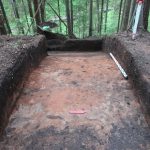Archaeological studies in the Kostroma region
At the end of May – June 2023 within the framework of the program “Structure, nature and dynamics of social and cultural interactions of the late Bronze Age – early Iron Age archaeological communities in the forest Volga region” the Kostroma Archaeological Expedition together with the Institute of Archaeology named after A.H. Khalikov of the Tatarstan Academy of Sciences with the support of the Kostroma branch of the Russian Geographical Society conducted archaeological studies on the Odoyevskoye settlement in the Sharya district of the Kostroma region.
In addition to the specialists of the Kostroma Archaeological Expedition, the Institute of Archaeology named after A.Kh. Khalikov, members of the Kostroma regional branch and Sharya local branch of the Russian Geographical Society, 2023 expedition also included members of the Historical Reconstruction Club “Sirin” (Kostroma), volunteers from the “Berendei” School Forestry of the Zeblyaki school and the village of Odoyevskoye of the Sharya district, Kostroma region.
Odoyevskoye settlement was studied for the first time in 1883 by F.D. Nefyodov, a member of the Society of Devotees of Natural Science, Anthropology, and Ethnography. In 1903 N.M. Bekarevich laid small trenches on the site. In 1925-1926, a complex expedition of the Institute of Anthropology of the Moscow State University under the leadership of B.S. Zhukov conducted large-scale studies in the Vetluga river basin, including the Odoyevskoye settlement.
2023 excavation was laid on the western slope of the site that mostly exposed to the destruction. In the current field season more than 7000 finds (from clay, bone, stone, ferrous and non-ferrous metals) have been found. The thickness of the cultural layer at the research site is 120 cm. The lower horizons of the cultural layer date to the VII-III century BC and belong to the Vyatka-Vetluga archaeological culture ACHA (Ananyino cultural and historical area). The upper horizons of the cultural layer following the Ananyino ones continue to be formed during the first half of the I millennium AD.
Further studies of the site are undoubtedly of great importance for solving urgent issues, related to the understanding of the genesis and development of the Vetluga river basin population. The great scientific significance of the ancient settlement is also emphasized by the presence of several cultural and chronological complexes of the early Iron Age and early Middle Ages.





